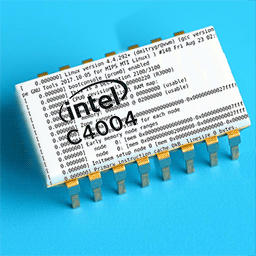- cross-posted to:
- hacking@lemmy.ml
- cross-posted to:
- hacking@lemmy.ml
TL;DR
I booted Debian Linux on a 4-bit intel microprocessor from 1971 - the first microprocessor in the world - the 4004. It is not fast, but it is a real Linux kernel with a Debian rootfs on a real board whose only CPU is a real intel 4004 from the 1970s. The video is sped up at variable rates to demonstrate this without boring you. The clock and calendar in the video are accurate. A constant-rate video is linked below.



That’s a really good question and I had to know, the answer is kinda neat:
Why they jumped to 4000 from 1000 tho, I didn’t see.
If I may venture a guess:
There are four of these chips (1302, 1105, 1507, 1202). Someone, trying to speed-talk, referred to them as the “four thousand-series chips” (instead of the “four, one-thousand-series chips”), and someone misheard or misunderstood that as the “4000-series chips”. After several levels of this telephone game, marketing got involved, and they were just renamed into the 4000 series instead of redoing the marketing documents.
Just a guess.